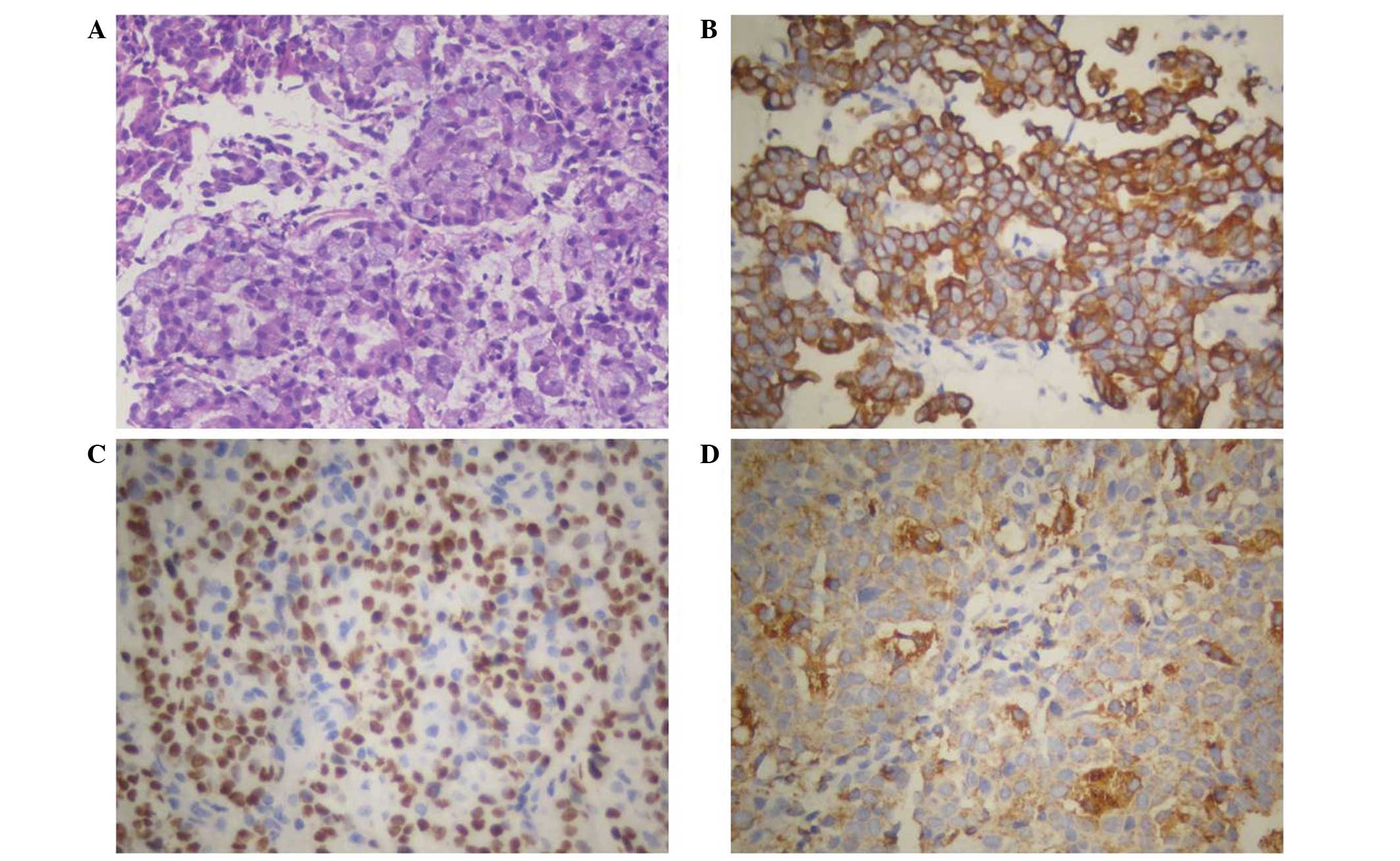Metastatic lung adenocarcinoma to the bladder: A case report
- Authors:
- Hai‑Jun Ye
- Jian Ma
- Ying‑Jie Liu
- Xiao‑Fei Ye
- Li‑Wang Zhang
- Jin‑Ge Li
View Affiliations
Affiliations: Department of Pathology, People's Liberation Army 205 Hospital, Jinzhou, Liaoning 121000, P.R. China, Department of Research Service, Tangdu Hospital, The Fourth Military Medical University, Xi'an, Shaanxi 710038, P.R. China, Department of Infectious Disease, Tangdu Hospital, The Fourth Military Medical University, Xi'an, Shaanxi 710038, P.R. China
- Published online on: July 1, 2015 https://doi.org/10.3892/ol.2015.3445
-
Pages:
1674-1676
Metrics: Total
Views: 0 (Spandidos Publications: | PMC Statistics: )
Metrics: Total PDF Downloads: 0 (Spandidos Publications: | PMC Statistics: )
This article is mentioned in:
Abstract
Urothelial cancer is the most frequently diagnosed type of malignant tumor in the bladder, of which primary adenocarcinoma accounts for a small percentage. Secondary malignancies, in particular metastatic adenocarcinoma from the lung, are exceedingly rare, with only six cases previously reported in the literature. The present study describes the case of a 71‑year‑old Chinese male patient with known lung cancer for >2 years, who was diagnosed with metastatic adenocarcinoma to the bladder. The histopathological characteristics and immunohistochemical features of the patient are reported. It was proposed that pathologists should consider the possibility of metastatic adenocarcinoma from the lung, rather than assume a diagnosis of primary adenocarcinoma of the bladder or direct invasion of adenocarcinoma from the surrounding organs. Furthermore, it is essential to determine the medical history of each patient and observe the immunohistochemical features of all tumors prior to diagnosis.
View References
|
1
|
Howlader N, Noone AM, Krapcho M, et al:
SEER Cancer Statistics Review, 1975–2009 (Vintage 2009
Populations)National Cancer Institute; Bethesda, MD: 2012
|
|
2
|
Wasco MJ, Daignault S, Zhang Y, et al:
Urothelial carcinoma with divergent histologic differentiation
(Mixed Histologic Features) predicts the presence of locally
advanced bladder cancer when detected at transurethral resection.
Urology. 70:69–74. 2007. View Article : Google Scholar : PubMed/NCBI
|
|
3
|
Thomas DG, Ward AM and Williams JL: A
study of 52 cases of adenocarcinoma of the bladder. Br J Urol.
43:4–15. 1971. View Article : Google Scholar : PubMed/NCBI
|
|
4
|
Modh RA, Corbyons KA and Yeung LL: A rare
metastasis to the bladder. Case Rep Urol.
2013:7890392013.PubMed/NCBI
|
|
5
|
Bates AW and Baithun SI: Secondary
neoplasms of the bladder are histological mimics of nontransitional
cell primary tumours: Clinicopathological and histological features
of 282 cases. Histopathology. 36:32–40. 2000. View Article : Google Scholar : PubMed/NCBI
|
|
6
|
Martín-Marquina Aspiunza A, Díez-Caballero
Alonso F, Rodríguez-Rubio Cortadellas FI, Díez Fernández L, Abad
Vivas-Pérez JI, et al: Bladder metastasis of lung adenocarcinoma.
Actas Urol Esp. 21:406–408. 1997.(In Spanish). PubMed/NCBI
|
|
7
|
Sakhri L, Mennecier B, Jacqmin D, Di Marco
A, Schumacher C, Chenard MP, Bergmann E and Quoix E: Atypical
metastatic site of lung adenocarcinoma. Rev Pneumol Clin.
67:375–379. 2011.(In French). View Article : Google Scholar : PubMed/NCBI
|
|
8
|
Karle W, Barazani Y and Tareen B: A rare
case of metastatic lung cancer to the bladder. Can Urol Assoc J.
6:E147–E149. 2012.PubMed/NCBI
|
|
9
|
Shirakawa H, Kozakai N, Sawafuji M,
Sugiura H and Hara S: Urinary bladder metastasis originating from
lung adenocarcinoma: A case definitively diagnosed by
immunohistochemistry. Urol J. 9:530–532. 2012.PubMed/NCBI
|
|
10
|
Acino SM and Hampel N: Renal cell
carcinoma presenting with gross haematuria from a solitary bladder
metastasis. Eur Urol. 15:294–296. 1988.PubMed/NCBI
|
|
11
|
Turner BM, Cagle PT, Sainz IM, et al:
Napsin A, a new marker for lung adenocarcinoma, is complementary
and more sensitive and specific than thyroid transcription factor 1
in the differential diagnosis of primary pulmonary carcinoma:
evaluation of 1674 cases by tissue microarray. Arch Pathol Lab Med.
136:163–171. 2012. View Article : Google Scholar : PubMed/NCBI
|










